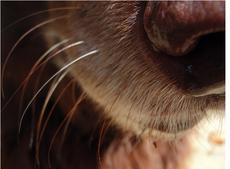I recently brought my old Nova Scotia Duck Tolling Retriever, Dancer, to a dog groomer to be washed, brushed, and trimmed. The regular groomer was away that day and I didn't know the girl who was filling in for her. She took one look at him and exclaimed, "Oh my! He certainly does need grooming. Look at the length of his whiskers. We will have to clip those off so that his face looks more trim and tidy."
I reflexively put my arm around him in a protective manner and said, "Please leave his whiskers be."
Dogs have a set of stiff hairs protruding from the sides of their muzzles that are popularly called "whiskers." These are not at all like the nonfunctional whiskers that men sometimes grow on their faces and they are technically called vibrissae. Cats have similar hairs and people often refer to these as "feelers" and this may be a better name since vibrissae really are sophisticated devices that help the dog feel its way through the world. They are quite different from most other hairs on the dog's body, since they are considerably more rigid and embedded more deeply into the skin. At the base of each vibrissa is a high concentration of touch sensitive neurons.
Vibrissae are found in a variety of other animals including cats, rats, bears, and seals, which suggests that they must serve a useful function. One way to determine how important something is to animal is to see how much of the brain it uses. Of those areas of the brain that register touch information in the dog, nearly 40 percent of it is dedicated to the face, with a disproportionately large amount of that dedicated to the regions of the upper jaw where the vibrissae are located. You can actually map each individual vibrissa to a specific location in the dog's brain, suggesting that great importance is assigned to information from these structures.
The vibrissae serve as an early warning device that something is near the face, and thus prevent colliding with walls and objects, and keep approaching objects from damaging the dog's face and eyes. You can demonstrate this for yourself by tapping gently on the vibrissae of a dog. With each tap, the eye on the same side of the face will blink protectively, and the dog will tend to turn its head away from the side tapped.
The vibrissae also seem to be involved in the location of objects, and perhaps in the recognition of the objects themselves. Most animals use vibrissae much the way that a blind person uses a cane. First, the little muscles that control the vibrissae direct them somewhat forward when the dog is approaching an object. Next they actively "whisk," or vibrate slightly while the dog swings his head to drag these hairs across surfaces. Whisking gives information about the shape and roughness of surfaces near his head. Since the dog's eyes can't focus very well on close objects, and his muzzle blocks his line of sight when he is looking at things near his mouth, the information from the forward and downward pointed vibrissae appears to help him locate, identify, and pick up small objects with his mouth.
Many dog fanciers are unaware of the importance of vibrissae to the dog, and most groomers, such as this one that I just encountered, seem to consider vibrissae as a purely cosmetic feature, as if they were the same as human facial hair. Dogs of many different breeds routinely have their vibrissae cut in preparation for the show ring. It is argued that this gives the dog's head a "cleaner" look. Unfortunately, amputating vibrissae is both uncomfortable and stressful for dogs, and it reduces their ability to perceive their close surroundings fully.
Specifically, dogs whose vibrissae have been removed seem more uncertain in dim light. Under these conditions they actually move more slowly, because they are not getting the information that they depend upon to tell them where things are that they might bump into. With intact vibrissae, the dog actually does not have to make physical contact with a surface to know it is there. These special hairs are so sensitive that they also register slight changes in air currents. As a dog approaches an object like a wall, some of the air that he stirs up by moving bounces back from surfaces, bending the vibrissae slightly, which is enough to inform him that something is near well before he touches it.
I particularly did not want Dancer's vibrissae removed since at age 14 years he has already lost the vision in his left eye. Dogs with reduced vision depend even more on the sensations from their vibrissae to help avoid bumping into things. So in my typical university professor style I tried to explain why his whiskers should not be removed to the young groomer.
She looked at me blankly and responded, "But if I remove his whiskers his face will look much cleaner and neater."
I sighed and searched for another way to explain it to her. Finally I said, "Look, he is an old dog, and old men are allowed to have whiskers on their face and so are old dogs. So leave them be."
She smiled and nodded, giving a brief "I understand now" and I left feeling my dog's important facial paraphernalia would remain intact for now.

